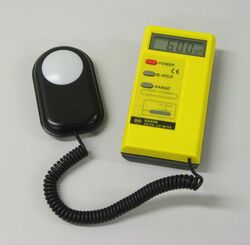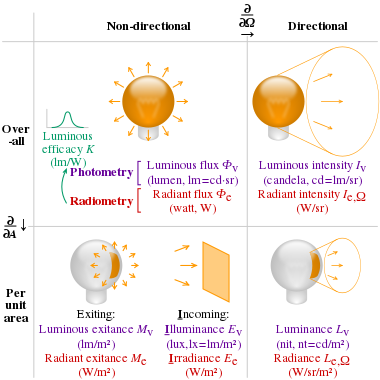Illuminance
Topic: Physics
 From HandWiki - Reading time: 4 min
From HandWiki - Reading time: 4 min
| Illuminance | |
|---|---|
Common symbols | Ev |
| SI unit | lux |
Other units | phot, foot-candle |
| In SI base units | cd·sr·m−2 |
| Dimension | [math]\displaystyle{ \mathsf{L}^{-2} \mathsf{J} }[/math] |
File:Illuminance Diagram.tif In photometry, illuminance is the total luminous flux incident on a surface, per unit area.[1] It is a measure of how much the incident light illuminates the surface, wavelength-weighted by the luminosity function to correlate with human brightness perception.[2] Similarly, luminous emittance is the luminous flux per unit area emitted from a surface. Luminous emittance is also known as luminous exitance.[3][4]
In SI units illuminance is measured in lux (lx), or equivalently in lumens per square metre (lm·m−2).[2] Luminous exitance is measured in lm·m−2 only, not lux.[4] In the CGS system, the unit of illuminance is the phot, which is equal to 10000 lux. The foot-candle is a non-metric unit of illuminance that is used in photography.[5]
Illuminance was formerly often called brightness, but this leads to confusion with other uses of the word, such as to mean luminance. "Brightness" should never be used for quantitative description, but only for nonquantitative references to physiological sensations and perceptions of light.
The human eye is capable of seeing somewhat more than a 2 trillion-fold range. The presence of white objects is somewhat discernible under starlight, at 5×10−5 lux, while at the bright end, it is possible to read large text at 108 lux, or about 1000 times that of direct sunlight, although this can be very uncomfortable and cause long-lasting afterimages.[citation needed]
Common illuminance levels
| Lighting condition | Foot-candles | Lux |
|---|---|---|
| Sunlight | 10,000 [6] | 107,527 |
| Shade on a sunny day | 1,000 | 10,752 |
| Overcast day | 100 | 1,075 |
| Very dark day | 10 | 107 |
| Twilight | 1 | 10.8 |
| Deep twilight | 0.1 | 1.08 |
| Full moon | 0.01 | 0.108 |
| Quarter moon | 0.001 | 0.0108 |
| Starlight | 0.0001 | 0.0011 |
| Overcast night | 0.00001 | 0.0001 |
Astronomy
In astronomy, the illuminance stars cast on the Earth's atmosphere is used as a measure of their brightness. The usual units are apparent magnitudes in the visible band.[7] V-magnitudes can be converted to lux using the formula[8] [math]\displaystyle{ E_\mathrm{v} = 10^{(-14.18-m_\mathrm{v})/2.5}, }[/math] where Ev is the illuminance in lux, and mv is the apparent magnitude. The reverse conversion is [math]\displaystyle{ m_\mathrm{v} = -14.18 - 2.5 \log(E_\mathrm{v}). }[/math]
Relation to luminance
The luminance of a reflecting surface is related to the illuminance it receives: [math]\displaystyle{ \int_{\Omega_\Sigma} L_\mathrm{v} \mathrm{d}\Omega_\Sigma \cos \theta_\Sigma = M_\mathrm{v} = E_\mathrm{v} R }[/math] where the integral covers all the directions of emission ΩΣ, and
- Mv is the surface's luminous exitance
- Ev is the received illuminance, and
- R is the reflectance.
In the case of a perfectly diffuse reflector (also called a Lambertian reflector), the luminance is isotropic, per Lambert's cosine law. Then the relationship is simply [math]\displaystyle{ L_\mathrm{v} = \frac{E_\mathrm{v} R}{\pi} }[/math]
See also
References
- ↑ "Illuminance, 17-21-060". CIE S 017:2020 ILV: International Lighting Vocabulary, 2nd edition.. CIE - International Commission on Illumination. 2020. https://cie.co.at/eilvterm/17-21-060. Retrieved 20 April 2023.
- ↑ 2.0 2.1 International Electrotechnical Commission (IEC): International Electrotechnical Vocabulary. ref. 845-21-060, illuminance
- ↑ Luminous exitance Drdrbill.com
- ↑ 4.0 4.1 International Electrotechnical Commission (IEC): International Electrotechnical Vocabulary. ref. 845-21-081, luminous exitance
- ↑ One phot = 929.030400001 foot-candles, according to http://www.unitconversion.org/unit_converter/illumination.html
- ↑ "Illuminance - Recommended Light Level". The Engineering ToolBox. https://www.engineeringtoolbox.com/light-level-rooms-d_708.html.
- ↑ Schlyter, Paul. "Radiometry and photometry in astronomy FAQ, section 7". http://stjarnhimlen.se/comp/radfaq.html#7.
- ↑ "Formulae for converting to and from astronomy-relevant units". http://members.ziggo.nl/jhm.vangastel/Astronomy/Formules.pdf.
External links
- Illuminance Converter
- Knowledgedoor, LLC (2005) Library of Units and Constants: Illuminance Quantity
- Kodak's guide to Estimating Luminance and Illuminance using a camera's exposure meter. Also available in PDF form.
| Quantity | Unit | Dimension | Notes | |||||
|---|---|---|---|---|---|---|---|---|
| Name | Symbol[nb 1] | Name | Symbol | Symbol[nb 2] | ||||
| Luminous energy | Qv[nb 3] | lumen second | lm⋅s | T⋅J | The lumen second is sometimes called the talbot. | |||
| Luminous flux, luminous power | Φv[nb 3] | lumen (= candela steradians) | lm (= cd⋅sr) | J | Luminous energy per unit time | |||
| Luminous intensity | Iv | candela (= lumen per steradian) | cd (= lm/sr) | J | Luminous flux per unit solid angle | |||
| Luminance | Lv | candela per square metre | cd/m2 | L−2⋅J | Luminous flux per unit solid angle per unit projected source area. The candela per square metre is sometimes called the nit. | |||
| Illuminance | Ev | lux (= lumen per square metre) | lx (= lm/m2) | L−2⋅J | Luminous flux incident on a surface | |||
| Luminous exitance, luminous emittance | Mv | lux | lx | L−2⋅J | Luminous flux emitted from a surface | |||
| Luminous exposure | Hv | lux second | lx⋅s | L−2⋅T⋅J | Time-integrated illuminance | |||
| Luminous energy density | ωv | lumen second per cubic metre | lm⋅s/m3 | L−3⋅T⋅J | ||||
| Luminous efficacy (of radiation) | K | lumen per watt | lm/W | M−1⋅L−2⋅T3⋅J | Ratio of luminous flux to radiant flux | |||
| Luminous efficacy (of a source) | η[nb 3] | lumen per watt | lm/W | M−1⋅L−2⋅T3⋅J | Ratio of luminous flux to power consumption | |||
| Luminous efficiency, luminous coefficient | V | 1 | Luminous efficacy normalized by the maximum possible efficacy | |||||
| See also: SI · Photometry · Radiometry | ||||||||
- ↑ Standards organizations recommend that photometric quantities be denoted with a subscript "v" (for "visual") to avoid confusion with radiometric or photon quantities. For example: USA Standard Letter Symbols for Illuminating Engineering USAS Z7.1-1967, Y10.18-1967
- ↑ The symbols in this column denote dimensions; "L", "T" and "J" are for length, time and luminous intensity respectively, not the symbols for the units litre, tesla and joule.
- ↑ 3.0 3.1 3.2 Alternative symbols sometimes seen: W for luminous energy, P or F for luminous flux, and ρ for luminous efficacy of a source.
 |
 KSF
KSF

